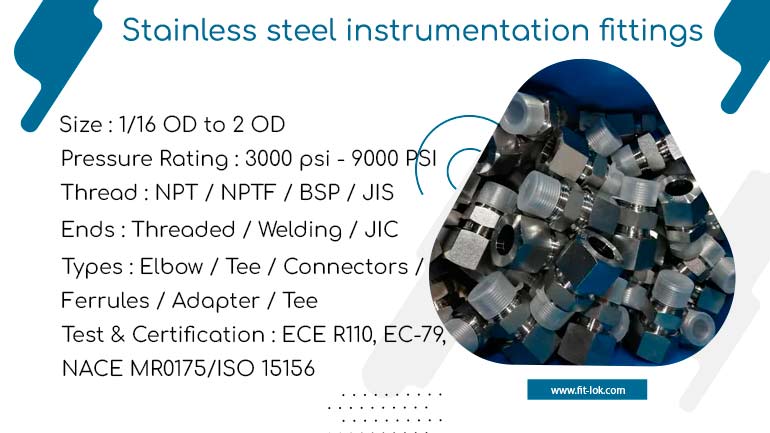Why SS Instrumentation Fittings Are Essential in Oil & Gas Industries

Strong 8k brings an ultra-HD IPTV experience to your living room and your pocket.
Every part of the pipeline network is essential to maintaining smooth, secure, and effective operations in the challenging field of oil and gas exploration and processing. Stainless steel (SS) instrumentation fittings are among the most important components among them. These intricately designed parts handle everything from caustic chemicals to high-pressure gas and are used to connect, regulate, and meter flow in intricate pipe systems. Onshore refineries exposed to chemical fumes, offshore rigs pummeled by salt-laden winds, and high-temperature, high-pressure pipelines that may test the boundaries of any material are just a few of the severe settings that define the oil and gas sector. The intrinsic qualities of stainless steel instrumentation fittings make them essential in such demanding environments.
Stainless steel instrumentation fittings' remarkable resistance to corrosion is the main factor that makes them so important in oil and gas applications. Hydrocarbons, chlorides, and hydrogen sulfide (H₂S) are among the hostile compounds that pipelines and equipment frequently manage in both the upstream and downstream sectors. Standard alloys can corrode quickly when even minute amounts of moisture are combined with these substances. Long service life and fewer maintenance are guaranteed by the exceptional resistance to pitting, crevice corrosion, and stress corrosion cracking of stainless steel grades like SS 316 and SS 316L. For oil and gas operators, this directly translates into fewer shutdowns, fewer fitting replacements, and eventually significant cost savings.
The ability of stainless steel instrumentation tube fittings to retain mechanical integrity in the face of severe pressure and temperature changes is another crucial factor. During procedures like gas dehydration or crude distillation, temperatures can fluctuate significantly and pressure can reach thousands of psi in many oil and gas facilities. Fittings for stainless steel instruments are made to endure these demanding conditions without buckling, leaking, or failing due to fatigue. Even under cyclic stress, they keep their tight seals, which is crucial for stopping volatile substance leaks. Furthermore, at cryogenic temperatures, stainless steel retains its durability, which is particularly advantageous in LNG (liquefied natural gas) production facilities where temperatures fall well below zero.
In the oil and gas sector, where even a small leak can turn into a disastrous event, safety is a top issue. Stainless steel instrumentation fittings, including elbows, manifolds, pipe nipples, and double ferrule compression fittings, guarantee dependable, leak-free connections. Because they are accurately machined to provide consistent torque requirements and robust tube-gripping capabilities, there is less chance of human error during installation. The quality of these fittings can actually be the difference between safe operation and disaster in hazardous locations where safety valves and gas detectors rely on precise instrumentation lines. Because of this, a lot of oil and gas businesses require fittings that meet strict requirements like ASTM, ASME, and NACE MR0175 for sour service.
Excellent compatibility with a variety of process fluids, including sour gases and chemically treated water used in enhanced oil recovery (EOR), is another benefit of stainless steel instrumentation fittings. This adaptability makes inventory control and procurement easier for big oil and gas projects that are dispersed across several locations with different process conditions. In applications where purity is important, such as gas chromatograph sampling lines or injection skids, stainless steel's non-reactive nature also guarantees that the process fluid won't become contaminated. Stainless steel fittings are also simple to clean and inspect, which promotes system integrity and cleanliness during planned maintenance.
In addition to these technological advantages, stainless steel instrumentation fittings support contemporary oil and gas businesses' sustainability objectives. They complement efforts to reduce waste and enhance the overall environmental impact of projects because of their long lifespan and capacity for recycling. A lot of operators are shifting to asset reliability programs where decision-making heavily relies on lifecycle cost analysis. In such frameworks, the longer service life and lower maintenance requirements of stainless steel instrumentation fittings more than make up for their somewhat higher initial cost. This results in reduced overall ownership costs and enhanced safety measures across decades of operation, two factors that propel brand reputation and profitability in the global energy industry.
In conclusion, using stainless steel instrumentation fittings in the oil and gas sector is a strategic decision rather than just a technical one. They enhance long-term operating efficiency, guarantee leak-free performance in hazardous settings, and protect vital activities from corrosion, high pressures, and temperature extremes. The safe and effective operation of the oil and gas supply chain depends on stainless steel instrumentation tube fittings, valves, and connections, whether they are found in upstream drilling rigs, midstream pipelines, or downstream petrochemical complexes. An operator's dedication to safety, dependability, and long-term success in one of the most demanding industrial sectors in the world is demonstrated by their investment in premium stainless steel fittings.
Note: IndiBlogHub features both user-submitted and editorial content. We do not verify third-party contributions. Read our Disclaimer and Privacy Policyfor details.


